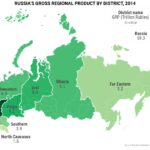Comparative advantage and absolute advantage are cornerstones of international trade and economics, deeply impacting how countries and businesses allocate resources to produce specific goods and services. COMPARE.EDU.VN offers a comprehensive exploration of these concepts, highlighting their differences and providing valuable insights for informed decision-making. Understanding these advantages is crucial for optimizing production, maximizing profits, and fostering mutually beneficial trade relationships. Explore the economic landscape with us, and discover the nuances of resource allocation, trade specialization, and the strategic advantages that drive global commerce, including factor endowments and terms of trade.
1. Understanding Absolute Advantage
Absolute advantage occurs when a country or business can produce a product or service more efficiently than another entity. This efficiency stems from various factors, including lower production costs, faster production rates, superior quality, or a combination of these elements. Essentially, absolute advantage signifies that one entity can produce more of a good or service with the same amount of resources, or the same amount of a good or service with fewer resources, compared to its competitors.
1.1. Key Factors Contributing to Absolute Advantage
Several elements contribute to a country’s or business’s absolute advantage. These include:
- Lower Labor Costs: Countries with lower labor costs can produce goods and services at a reduced overall cost, giving them an edge in industries that are labor-intensive.
- Access to Resources: Abundant access to natural resources, such as oil, minerals, or fertile land, can provide a significant advantage in producing goods that rely on these resources.
- Available Capital: A large pool of available capital enables investment in advanced technology, infrastructure, and production processes, enhancing efficiency and output.
- Technological Expertise: Expertise in specific technologies or innovative processes can enable a country or business to produce goods with greater efficiency and quality.
1.2. Examples of Absolute Advantage
Consider the following examples to illustrate absolute advantage:
- Saudi Arabia and Oil Production: Saudi Arabia possesses vast oil reserves and the infrastructure to extract and refine oil efficiently. This gives it an absolute advantage in oil production, allowing it to export oil to countries worldwide.
- China and Electronics Manufacturing: China has developed a robust manufacturing sector with skilled labor and advanced production facilities. This allows it to produce electronics at a lower cost and higher volume than many other countries, giving it an absolute advantage in electronics manufacturing.
- Italy and Luxury Car Production: Italy has a long-standing tradition of craftsmanship and expertise in designing and manufacturing luxury cars. This allows it to produce high-quality sports cars with greater efficiency and profit than many other countries, giving it an absolute advantage in the luxury car industry.
2. Understanding Comparative Advantage
Comparative advantage takes a broader perspective than absolute advantage. It considers the opportunity cost of producing goods and services. Opportunity cost is the value of the next best alternative that is forgone when making a decision. In the context of international trade, comparative advantage suggests that a country should specialize in producing goods and services for which it has the lowest opportunity cost, even if it does not have an absolute advantage in producing those goods.
2.1. Opportunity Cost: The Key to Comparative Advantage
Opportunity cost is a crucial concept in understanding comparative advantage. It represents the potential benefits that are missed when choosing one alternative over another. For example, if a country can produce both wheat and textiles but chooses to focus on wheat production, the opportunity cost is the value of the textiles it could have produced instead.
2.2. Calculating Comparative Advantage
To determine comparative advantage, one must calculate the opportunity cost for each country or business in producing each good or service. The country or business with the lowest opportunity cost for a particular good or service has a comparative advantage in producing that good or service.
Example:
Consider two countries, A and B, that can produce both wheat and textiles.
- Country A can produce 100 units of wheat or 50 units of textiles with its available resources.
- Country B can produce 80 units of wheat or 40 units of textiles with its available resources.
To calculate the opportunity cost, we need to determine how much of one good must be sacrificed to produce one unit of the other good.
- Country A:
- Opportunity cost of 1 unit of wheat = 50/100 = 0.5 units of textiles
- Opportunity cost of 1 unit of textiles = 100/50 = 2 units of wheat
- Country B:
- Opportunity cost of 1 unit of wheat = 40/80 = 0.5 units of textiles
- Opportunity cost of 1 unit of textiles = 80/40 = 2 units of wheat
In this example, both countries have the same opportunity cost for producing wheat and textiles. Therefore, neither country has a comparative advantage in producing either good.
2.3. How Comparative Advantage Drives International Trade
Comparative advantage drives international trade by encouraging countries to specialize in producing goods and services that they can produce at the lowest opportunity cost. This specialization leads to increased efficiency and overall production, benefiting all participating countries.
Example:
Consider two countries, C and D, that can produce both cars and computers.
- Country C can produce 60 cars or 40 computers with its available resources.
- Country D can produce 50 cars or 75 computers with its available resources.
Let’s calculate the opportunity cost:
- Country C:
- Opportunity cost of 1 car = 40/60 = 0.67 computers
- Opportunity cost of 1 computer = 60/40 = 1.5 cars
- Country D:
- Opportunity cost of 1 car = 75/50 = 1.5 computers
- Opportunity cost of 1 computer = 50/75 = 0.67 cars
In this case, Country C has a lower opportunity cost for producing cars (0.67 computers compared to 1.5 computers for Country D). Country D has a lower opportunity cost for producing computers (0.67 cars compared to 1.5 cars for Country C).
Therefore, Country C has a comparative advantage in producing cars, and Country D has a comparative advantage in producing computers.
Based on comparative advantage, Country C should specialize in car production and export cars to Country D, while Country D should specialize in computer production and export computers to Country C. This specialization and trade will lead to increased overall production and benefit both countries.
 Comparative advantage depicted through computer and car production between two countries
Comparative advantage depicted through computer and car production between two countries
3. Absolute Advantage vs. Comparative Advantage: Key Differences
While both absolute advantage and comparative advantage are important concepts in international trade, they differ in their focus and implications.
| Feature | Absolute Advantage | Comparative Advantage |
|---|---|---|
| Definition | Ability to produce a good or service more efficiently than others. | Ability to produce a good or service at a lower opportunity cost. |
| Focus | Efficiency and cost of production. | Opportunity cost and specialization. |
| Decision Factor | Producing goods at a lower cost or higher quality. | Specializing in goods with the lowest opportunity cost. |
| Trade Driver | Specialization based on efficiency. | Specialization based on opportunity cost. |
| Example | Saudi Arabia’s oil production. | Country C producing cars and Country D producing computers. |
3.1. When Absolute Advantage Matters
Absolute advantage is relevant when countries or businesses compete directly in producing similar goods or services. In these cases, the entity with the absolute advantage can produce more efficiently, gain a larger market share, and generate higher profits.
3.2. When Comparative Advantage is Crucial
Comparative advantage is crucial in determining trade patterns and specialization among countries or businesses. Even if one entity has an absolute advantage in producing all goods and services, it can still benefit from specializing in goods with the lowest opportunity cost and trading with others.
4. The Role of Adam Smith and David Ricardo
The concepts of absolute and comparative advantage have historical roots in classical economics.
4.1. Adam Smith and Absolute Advantage
Scottish economist Adam Smith introduced the concept of absolute advantage in his book The Wealth of Nations (1776). Smith argued that countries should specialize in producing goods that they can produce most efficiently and trade for goods that other countries can produce more efficiently. This specialization and trade would lead to increased overall production and benefit all participating countries.
4.2. David Ricardo and Comparative Advantage
British economist David Ricardo further developed the theory of international trade by introducing the concept of comparative advantage in his book On the Principles of Political Economy and Taxation (1817). Ricardo argued that countries should specialize in producing goods for which they have the lowest opportunity cost, even if they do not have an absolute advantage in producing those goods. This specialization would still lead to increased overall production and benefit all participating countries.
5. Real-World Applications of Comparative Advantage
Comparative advantage is not just a theoretical concept. It has practical implications for businesses, governments, and individuals.
5.1. Business Strategy
Businesses can use comparative advantage to guide their decisions about what goods and services to produce and where to locate their production facilities. By focusing on areas where they have a comparative advantage, businesses can increase their efficiency, reduce their costs, and improve their profitability.
5.2. Government Policy
Governments can use comparative advantage to inform their trade policies. By encouraging specialization in industries where a country has a comparative advantage, governments can promote economic growth, create jobs, and improve living standards.
5.3. Individual Career Choices
Individuals can also use comparative advantage to guide their career choices. By focusing on developing skills and expertise in areas where they have a comparative advantage, individuals can increase their earning potential and achieve greater career satisfaction.
6. Limitations of Comparative Advantage
While comparative advantage is a powerful concept, it has some limitations.
6.1. Assumptions
The theory of comparative advantage relies on several assumptions, such as:
- Perfect competition
- No transportation costs
- Constant opportunity costs
- No barriers to trade
These assumptions may not always hold true in the real world, which can limit the applicability of comparative advantage.
6.2. Dynamic Changes
Comparative advantage can change over time as technology, resources, and consumer preferences evolve. Countries and businesses must adapt to these changes to maintain their competitiveness.
6.3. Other Considerations
Other factors besides comparative advantage can influence trade patterns, such as political relationships, cultural factors, and environmental concerns.
7. Elaborating on Comparative Advantage: Beyond the Basics
To fully appreciate the concept of comparative advantage, it’s essential to delve deeper into its complexities and nuances. This involves considering various factors that influence comparative advantage, its dynamic nature, and its implications for trade and economic development.
7.1. The Role of Factor Endowments
Factor endowments, which refer to the resources a country possesses, play a significant role in determining its comparative advantage. These endowments can include natural resources, labor, capital, and technology.
- Natural Resources: Countries with abundant natural resources, such as oil, minerals, or fertile land, often have a comparative advantage in industries that rely on these resources. For example, Saudi Arabia’s vast oil reserves give it a comparative advantage in oil production.
- Labor: Countries with a large and skilled labor force may have a comparative advantage in labor-intensive industries, such as manufacturing or services. China’s large labor force has contributed to its comparative advantage in manufacturing.
- Capital: Countries with a well-developed financial system and abundant capital may have a comparative advantage in capital-intensive industries, such as finance or technology. The United States’ strong financial system has supported its comparative advantage in finance.
- Technology: Countries with advanced technological capabilities may have a comparative advantage in technology-intensive industries, such as software development or biotechnology. Silicon Valley’s concentration of technology companies has fueled the United States’ comparative advantage in technology.
7.2. The Influence of Technology
Technological advancements can significantly alter a country’s or business’s comparative advantage. New technologies can reduce production costs, improve product quality, and create entirely new industries.
- Automation: Automation can reduce the need for labor in manufacturing, potentially shifting comparative advantage from countries with low labor costs to countries with advanced technology.
- Information Technology: Information technology can facilitate communication and coordination across borders, making it easier for businesses to manage global supply chains and exploit comparative advantage in different locations.
- Biotechnology: Biotechnology can create new opportunities in agriculture, medicine, and other industries, potentially shifting comparative advantage to countries with strong research and development capabilities in these fields.
7.3. The Impact of Government Policies
Government policies can also play a significant role in shaping comparative advantage. Policies that promote education, research and development, infrastructure development, and trade liberalization can enhance a country’s competitiveness and shift its comparative advantage.
- Education: Investing in education and training can create a more skilled labor force, enhancing a country’s comparative advantage in knowledge-intensive industries.
- Research and Development: Supporting research and development can lead to technological innovation, creating new industries and shifting comparative advantage to countries that are at the forefront of innovation.
- Infrastructure Development: Investing in infrastructure, such as transportation and communication networks, can reduce transportation costs and improve the efficiency of supply chains, enhancing a country’s comparative advantage in trade.
- Trade Liberalization: Reducing trade barriers, such as tariffs and quotas, can increase trade and allow countries to specialize in industries where they have a comparative advantage.
7.4. Terms of Trade
The terms of trade refer to the ratio of a country’s export prices to its import prices. Changes in the terms of trade can affect a country’s gains from trade and its comparative advantage.
- Improved Terms of Trade: If a country’s export prices increase relative to its import prices, its terms of trade improve. This means that the country can import more goods and services for a given amount of exports, increasing its gains from trade.
- Worsened Terms of Trade: If a country’s export prices decrease relative to its import prices, its terms of trade worsen. This means that the country can import fewer goods and services for a given amount of exports, decreasing its gains from trade.
Changes in global demand, supply, and technology can affect the terms of trade and shift comparative advantage among countries.
8. Conclusion: Making Informed Decisions with COMPARE.EDU.VN
Understanding the nuances of absolute and comparative advantage is essential for making informed decisions in international trade, business strategy, government policy, and individual career choices. While absolute advantage focuses on producing goods and services more efficiently, comparative advantage emphasizes specialization based on opportunity cost.
COMPARE.EDU.VN provides comprehensive resources and tools to help you explore these concepts further and apply them to your specific needs. Whether you’re comparing different investment opportunities, evaluating business strategies, or making career decisions, COMPARE.EDU.VN offers the insights and analysis you need to succeed.
Don’t let the complexities of economic decision-making overwhelm you. Visit COMPARE.EDU.VN today and discover how we can help you make informed choices that lead to greater efficiency, profitability, and success. Our platform offers detailed comparisons, expert reviews, and user feedback, ensuring you have all the information you need at your fingertips.
For further inquiries, please contact us at:
Address: 333 Comparison Plaza, Choice City, CA 90210, United States
Whatsapp: +1 (626) 555-9090
Website: COMPARE.EDU.VN
9. Frequently Asked Questions (FAQ)
Q1: What is the main difference between absolute and comparative advantage?
A1: Absolute advantage refers to the ability to produce a good or service more efficiently than others, while comparative advantage refers to the ability to produce a good or service at a lower opportunity cost.
Q2: Can a country have both absolute and comparative advantage in the same product?
A2: Yes, a country can have both absolute and comparative advantage in the same product. However, it should specialize in the product where it has the greatest comparative advantage.
Q3: How does opportunity cost relate to comparative advantage?
A3: Opportunity cost is the foundation of comparative advantage. It represents the value of the next best alternative that is forgone when making a decision.
Q4: Why is comparative advantage important for international trade?
A4: Comparative advantage drives international trade by encouraging countries to specialize in producing goods and services that they can produce at the lowest opportunity cost, leading to increased overall production and benefit for all participating countries.
Q5: How can businesses use comparative advantage in their strategy?
A5: Businesses can use comparative advantage to guide their decisions about what goods and services to produce and where to locate their production facilities, increasing efficiency, reducing costs, and improving profitability.
Q6: What are some limitations of the theory of comparative advantage?
A6: Some limitations of the theory of comparative advantage include its reliance on assumptions such as perfect competition, no transportation costs, and constant opportunity costs.
Q7: How can governments influence comparative advantage?
A7: Governments can influence comparative advantage through policies that promote education, research and development, infrastructure development, and trade liberalization.
Q8: What are the terms of trade and how do they affect comparative advantage?
A8: The terms of trade refer to the ratio of a country’s export prices to its import prices. Changes in the terms of trade can affect a country’s gains from trade and its comparative advantage.
Q9: How does technology affect comparative advantage?
A9: Technological advancements can significantly alter a country’s or business’s comparative advantage by reducing production costs, improving product quality, and creating entirely new industries.
Q10: Where can I find more information on absolute and comparative advantage?
A10: You can find more information and detailed comparisons on compare.edu.vn, your go-to resource for making informed decisions.

